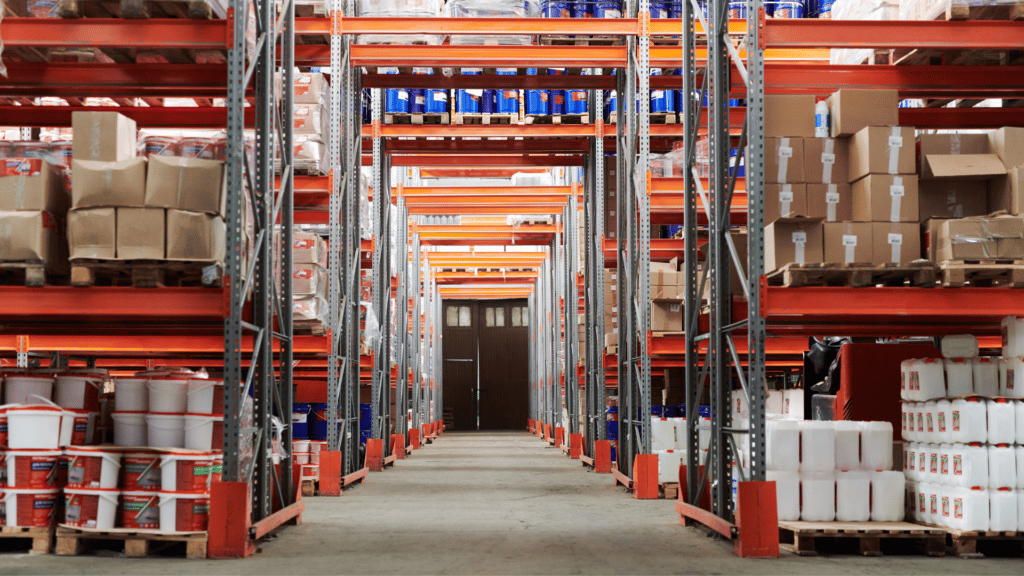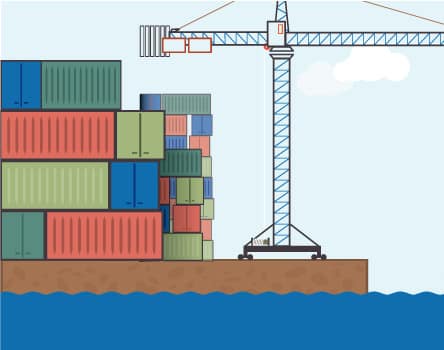Let’s say you run an eCommerce store. You start out shipping your own orders. But eventually, that turns into a pain and you hire a 3PL company to do that for you.
Or maybe you’re just considering hiring a 3PL company because you’re relatively new to eCommerce or you prefer doing it yourself.
In either case, you might wonder: how are these companies actually making money? Are they overcharging me? Are they operating on thin margins?
What happens inside of those warehouses, and how is it that these businesses can exist, and in many cases, be quite profitable?
In this article, we’re going to peel back the curtain and show you what happens behind the scenes at a 3PL company.
A Quick Definition of 3PL
When you see 3PL, it’s short for “third-party logistics.” You can call companies in this space “3PL companies,” or simply “3PLs.”
Technically, lots of different companies are 3PLs. Any company that handles part of logistics on behalf of another company is a 3PL, including order fulfillment centers, freight forwarders, and transportation companies.
But when you hear 3PL spoken out loud, especially in an informal context in the eCommerce space, people usually mean “order fulfillment center.”
So for the purposes of this article, we’re going to talk about order fulfillment centers.
How 3PL Companies Price Their Services
To answer this question, we’re going to borrow from our guest post on a CrowdCrux blog post called “How Much Does It Cost To Use a Fulfillment 3PL Center.” In it, we gave a brief overview of how 3PL companies price their services, quoted below:
No two fulfillment centers will have identical pricing. And even if they did, it would still take you some time to figure out what the price would be for your campaign in particular.
There’s simply no such thing as a one-size-fits-all estimate. Even online fulfillment center price calculators can only output ballpark figures.
So if you really want to understand how order fulfillment costs will look for your project, you need to request personalized quotes from each fulfillment center you’re considering. Each quote will be structured differently, so you’ll need to compare costs in a spreadsheet in order to really compare apples to apples. (We’ll cover that at the end).
As fluid as this process may seem, though, every fulfillment center will follow similar logic when providing their quotes. To that end, the basic formula to calculate order fulfillment costs is as follows:
Fulfillment Cost =
Account & Storage Fees +
((Postage + Supplies + Pick and Pack Fee) * Packages Shipped) +
Value-Added Services
From that, it’s tempting to think that every single one of these fees directly contributes to the bottom line of the company. But you might be surprised to hear that’s not the case.
In fact, there are relatively few ways that 3PLs make money, but many more that look like ways to make money, but are not actually all that profitable. And that’s not even factoring in all the expenses!
We’ll break that down in the next three sections.
Where 3PL Companies Generally Make Profits
If you want to know where money is really made in the 3PL business, you can’t necessarily look at revenue streams. Some revenue streams actually contribute to the bottom line, and some go right out the door to a third party, assuming the 3PL is even involved in the transaction at all.
One way 3PLs actually make serious money is through Pick and Pack Fees. Every time a product is retrieved from the warehouse and prepared for dispatch, a service fee is applied. This direct service charge, given the frequency of orders, can quickly amount to a significant sum, enhancing the profit margins of the 3PL company.
Another significant revenue stream comes in the form of Storage Fees. As eCommerce business owners, you might have noticed how 3PLs charge for warehousing space. This is especially true for products that sit longer on the shelves, since 3PLs are generally set up to where fast-moving inventory is preferred. Commercial real estate may not be cheap, and storage costs go a long way toward offsetting them. But even with that in mind, storage space is a good place to make some profit margin.
Value-added Services further boost profit potential. Clients often require more than just basic warehousing and shipping. They may need kitting, assembly, labeling, or even unique packaging. These services, while they might seem to fit outside of the bread-and-butter of order fulfillment, carry additional charges. These charges can help the 3PL turn a profit, and the right value-added services can even become a unique selling point for the 3PL as a business.
Some 3PLs also make significant money on Account Management Fees. At our own company, we waive account management fees as long as about 100 orders per month are going out the door. If we let inventory sit around for long, we would have wasted space and would have to raise the price of our core services. Other 3PLs tend not to waive account management fees, though at a large volume, they are often unnoticeable.
Lastly, the Receiving Fees come into play when products are delivered to the 3PL warehouses. Offloading and checking-in large shipments of products comes with fees and requires a lot of labor, which can supplement the 3PL’s revenue streams. Some 3PLs charge more on receiving fees and less on value-added services, others do the opposite – this is really a matter of both personal preference and the quirks of any given business environment which a 3PL must operate within.
Where 3PL Companies Generally Do Not Profit
While 3PL companies have numerous revenue streams, a lot of those streams don’t contribute much – if anything – to profit. The classic example is Shipping Fees or Postage Fees. This is often the single largest line item expense that 3PL customers see on their bill. But the vast majority of those fees go to shipping carriers. A 3PL can only really pocket profit margin on these fees if they negotiate well with carriers like UPS, FedEx, and USPS. (And even then, it’s often best to pass those savings on to clients because low postage rates can be an awesome selling point for a 3PL.)
Similarly, Packaging Material Costs don’t actually help a 3PL that much. If you, for example, decide your items need to be shipped in a nicer box, the 3PL will often only charge you at-cost and on a negotiated bulk rate at that.
Even in situations where 3PLs want to make some margin in this area, procuring raw materials, especially for branded or luxury packaging solutions, can be a pricey affair. The end result is that those margins end up being narrow anyway.
Your 3PL might also give you the opportunity to pay for Shipping Insurance. That insurance goes right to a third party, and the 3PL probably isn’t taking a cut. All a 3PL can do is negotiate favorable shipping insurance rates for their clients as a courtesy, because – in most cases – the shipping insurers are paid directly. And likewise, if your $2,000 watch is lost in the mail and you have to file a claim, the insurer is the one paying out the benefit.
There are definitely clear ways that 3PLs make money, and – as discussed in this section – there are a lot of ways that look like they are, but really aren’t. But it’s also important to consider all the expenses 3PL companies contend with as well and how they use their policies to mitigate them so they can provide favorable rates.
Where 3PL Companies Spend Money
If you’ve ever wondered why 3PL companies price their services the way they do, you would need to consider their expenses to really understand. There are a lot of them!
Let’s start with one of the most formidable ones: Warehouse Leasing or Ownership Costs. Space is very expensive. The closer a warehouse is to urban areas where a lot of people live, the more that space costs. Get too close to an urban area, and the price is too high. Get too far away, and postage rates become undesirable for clients. It’s a very difficult balance.
Then there’s the human element – Labor. Every worker needs to make a decent living, because working in warehouse is hard, physically intensive work! From the diligent picker pulling your product off a shelf to the packer ensuring it’s securely wrapped to the manager overseeing operations, everyone’s got to get paid.
If you’ve ever run a business, you know it’s not just about wages. There are also employment taxes, worker’s compensation, and benefits such as healthcare. It adds up quickly!
Utilities are another inevitable expenditure. Running a massive warehouse requires electricity to power lights and machines, water for various purposes, and an efficient HVAC system to maintain the desired environment.
And how about the machines, shelves, and security systems? They’re all a part of Equipment and Maintenance costs. It’s not just about the initial investment; regular upkeep is essential to prevent any disruptions.
Staying at the cutting edge of logistics often requires significant Technology Investments. Smart 3PL owners regularly upgrade their warehouse management systems, invest in advanced tracking tools, and ensure seamless eCommerce integrations. Falling behind on any of these areas can make a 3PL less attractive to prospective clients, starting a downward spiral.
Transportation incurs its own set of costs. Whether it’s partnering with carriers or managing fuel expenses for their fleet, the transportation budget is significant. And to keep operations streamlined, Training and Development for staff is ongoing, focusing on efficiency and safety.
Lastly, like all businesses, 3PLs need to put a chunk of their budget into Marketing and Sales, ensuring they attract and retain clients, including eCommerce businesses like yours.
Working with the right kind of clients is essential for 3PLs that want to succeed. So the best 3PLs want you to be sure you need them in the first place. More details on that in the following section.
How You Know If You Need a 3PL
Partnering with a 3PL is a big decision. If you do it too soon, it might be too expensive to be worth it. But if you wait too long, that’s just extra time you spend packing boxes on your own.
Here are six tell-tale signs:
- Your customer base is growing: If your customer base is skyrocketing, it might be time to delegate fulfillment.
- You can’t keep up with order volume: Are you consistently falling behind schedules or noticing more errors? A 3PL could be your solution.
- Either you or your staff are working too much: If your team is consistently clocking overtime because of shipping demands, a 3PL can ease the pressure.
- Your business feels too complex: As order fulfillment makes managing other facets of your business challenging, consider outsourcing.
- You’re running out of physical space: If you’re thinking about renting a storage unit for your inventory, it’s time to call a 3PL.
- Shipping fees are eating you alive: Believe it or not, a 3PL might not just save you hassle but also some hard-earned cash.
If any of these resonate with you, it might be time to explore a partnership with a 3PL. The right one could really make your company more efficient and scalable.
Final Thoughts
When you run an eCommerce store, it’s easy to rely on a 3PL company and not really know how it works. Because the operations happen behind closed doors, it can make price points and policies feel arbitrary.
But when you see how the money is really made, it’s a different story. Then it’s much easier to know what you can do to maximize your 3PL’s efficiency, save them money, and ultimately save yourself money. And in the end, it sets the stage for a friendly, mutually beneficial partnership.





